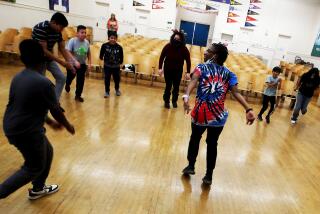Schools Must Learn to Subtract Harder : * Tough Times Force Districts Into Tough Decisions
- Share via
These clearly are not the best of times for Orange County school officials. A look at June’s stressful budgetary predicaments shows why:
In lamenting the need to begin charging for bus rides in Fountain Valley, Marc Ecker, assistant to the superintendent, recalled the nostalgic certainty of the arriving bus in “Leave It To Beaver.” He said, “Busing used to be basic, but now we call it a frill.”
Irvine is concerned enough about the reaction of parents to budget cuts that it sent out 4,500 surveys to those with children in the fourth, seventh and ninth grades. Before applying the ax, it shrewdly sought guidance on classroom and service programs that were considered most important.
In Santa Ana, the school board will cut seventh period, thus eliminating about 50 positions. And in a symbolic gesture, “zero-period” classes, those scheduled before the start of the regular school day for junior high students in the Irvine and Saddleback Valley unified districts, are slated for reduction or elimination. In Fullerton, when trustees met last week, teachers, parents and students complained about plans to cut back school district media specialists. There are fears that library and computer training will suffer.
And so it goes. The problem that the districts face was summed up well by Fullerton’s board member Robert C. Fisler, who said, “I would like to look at alternatives, but every one I come up with will step on someone’s toes.”
That seems to be the story during these tight budgetary times. There will be zero going on in “zero period.” Four thousand five hundred surveys go out as an early-warning system. The ordered world that once educated Ward and June Cleaver’s youngsters has been given a financial jolt.
If Beaver’s day suggested certainty, we seem to be witnessing now the erosion of assumptions about suburban life. The subdivisions spread out in part with the assured notion of educational opportunity. But they did so around the automobile and its companion for all semesters, the school bus. Orange County’s sprawling layout did not leave much room for walking to class.
We may have to pay to ride, but in so doing we are at risk of having a public education system resembling pay-per-view TV. You get a basic package and add programs according to an ability to pay. In some cases, as one budget director pointed out, it may come down to a difference between a bus ride and a math class. These turn out to be more than just painful choices. They are revolutionary in the sense that they derail public education as we have known it.
For the short term at least, the nervous preparations of the districts can cushion somewhat the inevitable blows that will be delivered from Sacramento. And if necessity is the mother of invention, there may also be ways of pooling ideas, and maybe even resources. Are there ways of sharing programs within or across district lines that administrators have not considered yet? The sheer variety of pained responses from these districts suggests a wealth of ideas for making due.
Inevitably, cuts are going to be made. Some electives or sports programs are going to go, or cost. These are not easy times and there are profound long-term questions to be answered about how “public” education is to work. For now, the watchword comes from Sal Mendoza, school board member in Santa Ana. He said, “Brace yourselves for some really, really, tough, tough decisions.”
More to Read
Sign up for Essential California
The most important California stories and recommendations in your inbox every morning.
You may occasionally receive promotional content from the Los Angeles Times.












